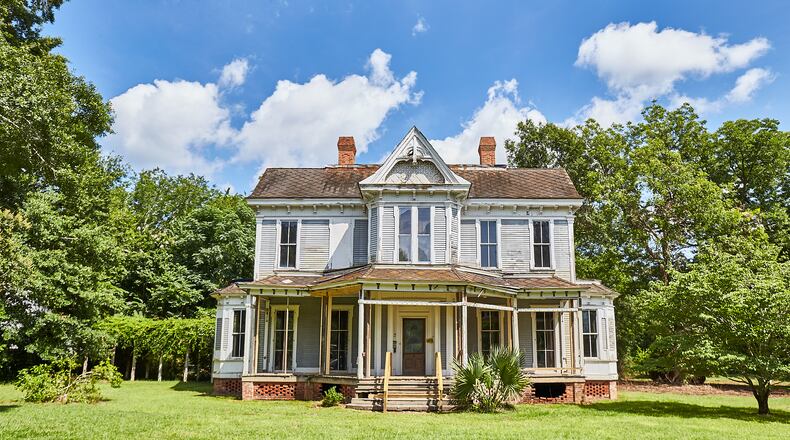Last year the Foster-Thomason-Miller House in Madison, Ga., was listed among Georgia's Top 10 historic structures in peril by the Georgia Trust for Historic Preservation.
A gorgeous example of the Aesthetic Movement, the 1883 house went through a brilliant renovation in the 1980s, only to have its pretty face spoiled by fire in 2001.
A rear section of the house was charred; most of the rest suffered some smoke and water damage. It sat empty for 18 years, quietly peeling, as the owner, the city and the neighbors disagreed about its fate.
It looked like the 5,000-square-foot house at 498 S. Main St. would either tumble down or be obliterated by development. (One plan called for the land to be subdivided into 37 lots.)
The house was snapped up by the Madison-Morgan Conservancy in May, and the conservancy went to work, fixing windows, sealing the roof, and stabilizing the structure. This month the conservancy put the house and an acre of land on the market for $449,000.
Should the non-profit organization find a buyer (there will be some strings attached) it will be a sterling example of an architectural gem being snatched from the jaws of death.
But nothing is quite that simple.
Currently the city of Madison has approved a developer’s plan to put 19 houses on the remaining 10 acres not purchased by the conservancy, most of which would be out of sight on the 1,000-foot-long parcel.
A neighborhood group is fighting that decision in court, in a case that should be resolved next week. But conflict may live on afterward, said Christine McCauley Watts, executive director of the conservancy.
"This community has been in so much turmoil over this property," she said, "but we can't let the property rot to the ground."
Success would mean finding a buyer willing to abide by requirements of Madison’s historic designation, which includes significant investment in restoration.
Entrepreneur Von Friesen, who sold the house and two acres to the conservancy, estimates it will take several hundred thousand to bring it back to glory.
That investment could be partly offset by federal rehabilitation tax credits, state rehabilitation tax credits, and a preferential property tax freeze that would keep the valuation at the present level for up to 10 years.
Those credits could be worth up to $200,000 said Watts.
“Everybody has been complaining about it for 18 years,” said Watts. “But if we can get it in the hands of somebody who will love it and bring it back to life, then we, and whoever buys it, are playing a vital role in the collective emotional state of this city. . . Everybody here knows how important that house is.”
The house was built in 1883 by an impressionable 23-year-old man named Legare H. Foster. Foster came into a fortune and spent it all, building a house with five bedrooms, two baths, 14-foot ceilings and its own natural gas production facility.
He sold the house to Robert Usher Thomason in 1889, and Thomason family members lived there through the 1970s. In 1978 it was sold to Richard and Marcia Miller who completed the restoration, winning the Georgia Trust for Historic Preservation’s award for residential restoration.
After the fire, the Millers sold it to Friesen.
The conservancy created a revolving fund to purchase the house and others like it. The fund is intended to allow them to buy historic properties, protect them and sell them.
“We decided two years ago we need to be more effective in protecting these properties,” said Watts.
“If we could own these properties, we could save some of these buildings.”
This purchase was made possible with support from the Watson-Brown Foundation, the 1772 Foundation and other donors.
Von Friesen, who is from Kansas, said the first sight of the slightly charred relic drew him to Madison.
“That house is the reason we live in Madison,” he said. “I live in an 1835 house (on the other side of town). I know how these beautiful monsters can keep giving. They can have soft floors and rotted things.”
But the Foster-Thomason-Miller house is strong he said. “The structure of this thing is good, the bones are very very, good. That’s what you need if you’re going to do a rehab project.”
About the Author
Keep Reading
The Latest
Featured






